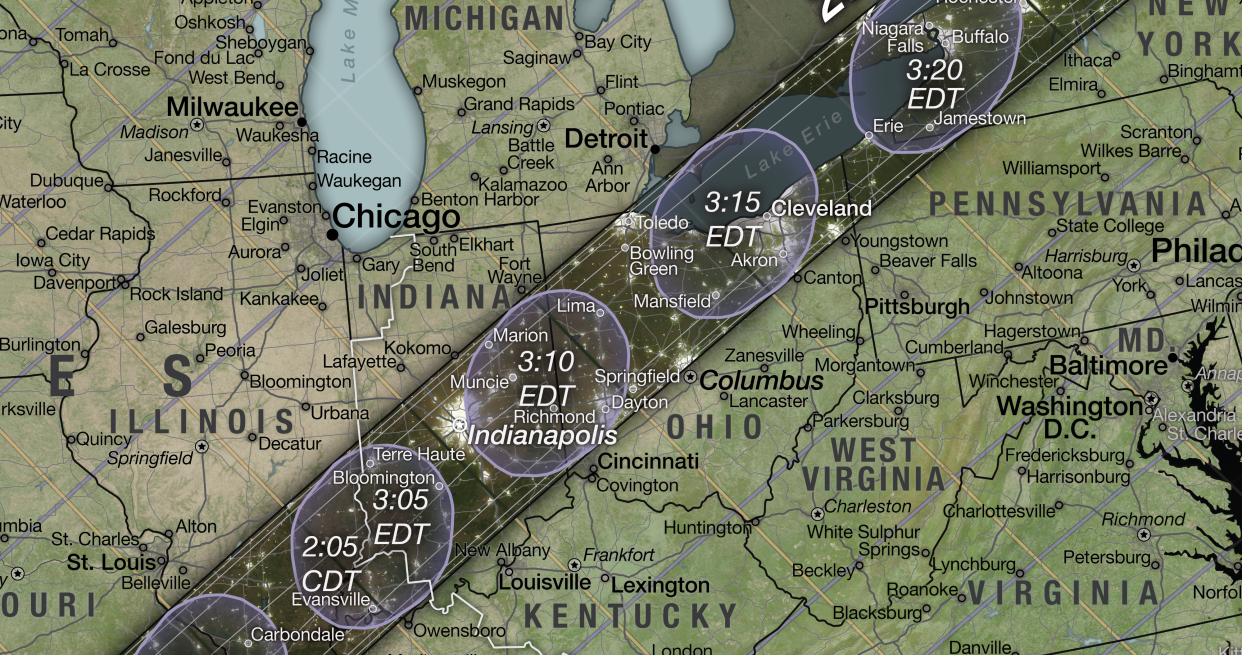5 things to know to view the 2024 total solar eclipse in Ohio: How to see it next year

One year from Saturday, Ohioans will be able to witness a once-in-a-lifetime event.
On Monday, April 8, 2024, residents will be able to view a total solar eclipse, the first time this will happen in Ohio in hundreds of years. The path of totality will cross the state from southwest to northeast, passing through cities like Cleveland, Akron and just outside Cincinnati. During the eclipse, the moon will completely block out the sun, casting a shadow on the Earth.
Next April, Ohioans will get the chance to see the sun in a way that is not possible at any other time. Here are five things you need to know about the total solar eclipse in 2024.
Where will the total solar eclipse be visible in Ohio?
People within a 124-mile-wide band in Ohio will experience the rare total solar eclipse. The path of totality will cross the state from southwest to northeast, passing through cities such as Toledo, Bowling Green, Lima, Mansfield, Akron, Cleveland, Springfield and Dayton. The total eclipse will last for approximately two minutes and 40 seconds.
A map from NASA's Scientific Visualization Studio also shows the location and shape of the moon's shadow during the eclipse, with the shadow over Dayton and Lima, for instance, at 3:10 p.m. and over Akron and Cleveland at 3:15 p.m.
Will you be able to see the solar eclipse in Cincinnati?
You may need to travel outside of Cincinnati to see the total solar eclipse, but a partial solar eclipse will be visible in Cincinnati.
The moon will be relatively closer to the Earth during the eclipse, which will make it larger and last longer. However, since Cincinnati is outside of the path of totality, the moon will not completely block out the sun. Instead, viewers will see a partial eclipse, with the moon covering a portion of the sun's disk. The sun will become about 99% obscured in Cincinnati during the peak of the eclipse.
Meteor showers, supermoons and more: 10 astronomical events to look for in 2023
When was the last time a total eclipse was visible in Ohio?
The 2024 total solar eclipse will be the first time in over 200 years that people in Ohio will be able to see a total solar eclipse.
On average, a total solar eclipse occurs somewhere on Earth every 1.5 years. However, only 21 total solar eclipses have crossed the lower 48 states in the entire existence of the United States. The last total solar eclipse visible in Ohio was in 1806. The next total solar eclipse in Ohio will be in 2099.
Will I need glasses to view the eclipse?
You may already be aware that this isn't your first eclipse, but you will need glasses to view this phenomenon.
Special eclipse glasses are necessary to filter out the harmful ultraviolet and infrared light from the sun. Eclipse glasses can be purchased at many stores or can be ordered online. The eclipse can also be viewed through telescopes, binoculars and cameras with solar filters and pinhole or similar projection methods.
It is never safe to look directly at the sun, even during a partial eclipse. This also applies during a total eclipse up until the sun is completely blocked, so it will be important to know when to take off and put back glasses.
This article originally appeared on Cincinnati Enquirer: What to know about the 2024 solar eclipse over Ohio

